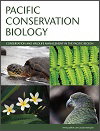Pacific Conservation Biology
Volume 30
Number 5 2024
Invasive animals’ wide-ranging activity complicates monitoring and control. For improved management, identifying areas of high use is crucial. Analysing spatial data from 35 feral cats, this study compared core range estimation methods. The α-hull method outperformed others and could improve the efficiency of further habitat use assessments.
This study on Fiji’s maskray (Neotrygon sp.) used cytochrome oxidase subunit 1 barcoding and genome-wide single nucleotide polymorphisms markers to reveal stable genetic diversity over 7 years, despite a significant size reduction. The species is likely susceptible to fishing pressure and exhibiting low reproductive output. The study provided insights into the genetic diversity of Fiji’s maskray and enabled a genetic comparison with current Neotrygon species known in the region as well as potential new taxonomic considerations.
A decision support tool was developed to aid conservation efforts by mapping species connectivity for forest-dependent vertebrate fauna in eastern and south-western Australia. It provides information on habitat connectivity and optimal pathways for a single focal species and four species guilds, facilitating interactive exploration of connectivity data and allowing users to download spatial datasets.
Despite the popularity of Tonga’s Special Management Area (SMA) program with Tongan communities, its rapid expansion in recent years has made monitoring and evaluation of the program a challenge. Consistent and effective monitoring and evaluation is needed to understand known impacts of SMAs postintervention. Hence, this manuscript compiles all known ecological, fisheries, and socio-economic monitoring and evaluation reports related to Tonga’s SMAs from 2010 onwards to suggest some ways towards an organised national program.
Protracted disconnection from the ocean, low rainfall and high evaporation led to salinities in Hamersley Inlet, south-western Australia, reaching 345 ppt, the highest recorded for an estuary. These conditions resulted in the loss of the fish fauna and associated ecosystem services. Climate change may increase the frequency of such events.
Tetepare Island is managed for conservation and remains the largest uninhabited island in the South Pacific. An unidentified Ixobrychus bittern recorded on Tetepare in September 2023 may represent an undescribed species. This record highlights the importance of such islands for regional conservation, as well as the need for ongoing research.
The protection of threatened species in fenced safe havens has become a vital component of conservation in Australia. However, despite their success, fenced safe havens face several ecological and economic constraints. Here, we explore naturally occurring mesas as potential ‘sky-island safe havens’ created by natural barriers in elevation and relief. The absence or lower numbers of invasive predators detected suggests mesas could be harnessed as supplementary conservation strategies that go ‘beyond the fence’..
The Thomas trap was designed in 2003 to reduce injuries to macropods during capture. We describe several modifications to the original trap design to improve use and capture success.





